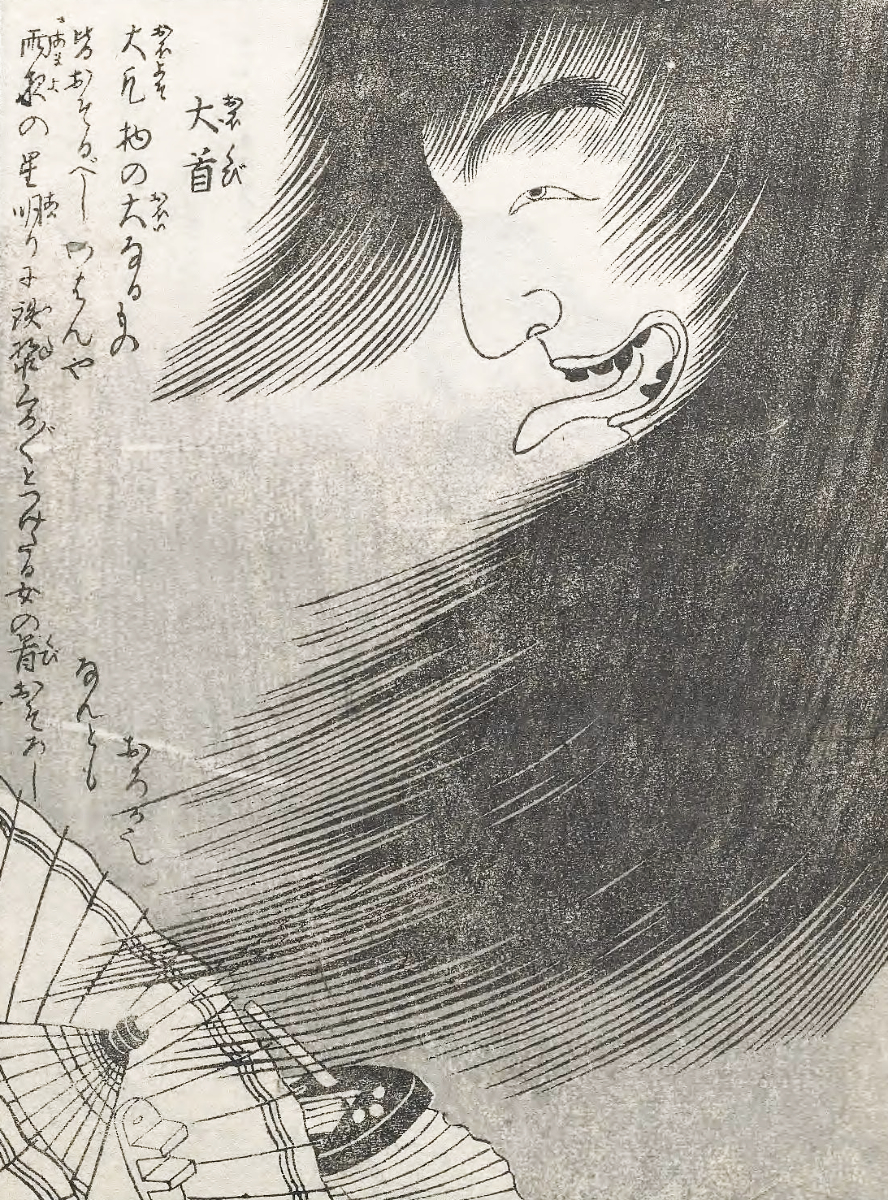Ōkubi is a Japanese yōkai. Its image is mostly a huge female head and has the characteristics of a married woman’s teeth painted black. Their true identities are said to be human vengeful spirits and obsessions turned into yōkai. Some say that Ōkubi is not a Japanese monster in folklore but was created to satirize monks who broke their precepts. There is such a story in Tōtei Bukkairoku, a collection of monster stories in the mid-Edo period. When the protagonist opened his storage room one day, he saw a huge old woman’s face. It was very weird, and he called it Ōkubi’s yōkai (the monster with the giant head). The protagonist poked the giant face with tongs, but Okubi didn’t respond, and when he touched it with his hands, it felt sticky. Ōkubi has the ability to make people sick. The mid-Edo period haiku poet Hori Bakusui wrote about Ōkubi in his works. It was a night after the rain, when the moon came out, and with the sound of thunder, a Ōkubi about 2 meters high appeared on the top of the wall. This Ōkubi blew on someone, and the part touched by the breath immediately turned yellow and swollen. Later, the doctor prescribed a medicated bath to cure it. There is a story titled Ōkubi in the short story collection Hyakkiyakou-yō (百鬼夜行―陽) by Natsuhiko Kyogoku. At the end of the story, it was the vision that the protagonist, who blamed himself for his ugly sexual desire, saw in the morgue. The Ōkubi laughed loudly in the appearance of the female corpse in the morgue, and later transformed into the faces of the women who had sex with the protagonist, and finally it turned into a combination of many female genitals. Like Ōkubi, Japanese folklore also has some yōkai whose heads are prominent features. See also Rokurokubi and Wanyūdō.
| Alias Ōkubi (大首) |
| Real Names/Alt Names “The giant head” |
| Characteristics Disembodied Body Part, Yōkai, Enlightenment and Neoclassicism, Japanese |
| Creators/Key Contributors Toriyama Sekien, ○ |
| First Appearance Japanese folklore |
| First Publisher ○ |
| Appearance List Konjaku Gazu Zoku Hyakki (今昔画図続百鬼, “The Illustrated One Hundred Demons from the Present and the Past”, 1779) Vol. 3 |
| Sample Read Konjaku Gazu Zoku Hyakki Vol. 3 “Dawn” (1779) [Smithsonian] |
| Description Ōkubi is a Japanese yōkai. Its image is mostly a huge female head and has the characteristics of a married woman’s teeth painted black. Their true identities are said to be human vengeful spirits and obsessions turned into yōkai. Some say that Ōkubi is not a Japanese monster in folklore but was created to satirize monks who broke their precepts. There is such a story in Tōtei Bukkairoku, a collection of monster stories in the mid-Edo period. When the protagonist opened his storage room one day, he saw a huge old woman’s face. It was very weird, and he called it Ōkubi’s yōkai (the monster with the giant head). The protagonist poked the giant face with tongs, but Okubi didn’t respond, and when he touched it with his hands, it felt sticky. Ōkubi has the ability to make people sick. The mid-Edo period haiku poet Hori Bakusui wrote about Ōkubi in his works. It was a night after the rain, when the moon came out, and with the sound of thunder, a Ōkubi about 2 meters high appeared on the top of the wall. This Ōkubi blew on someone, and the part touched by the breath immediately turned yellow and swollen. Later, the doctor prescribed a medicated bath to cure it. There is a story titled Ōkubi in the short story collection Hyakkiyakou-yō (百鬼夜行―陽) by Natsuhiko Kyogoku. At the end of the story, it was the vision that the protagonist, who blamed himself for his ugly sexual desire, saw in the morgue. The Ōkubi laughed loudly in the appearance of the female corpse in the morgue, and later transformed into the faces of the women who had sex with the protagonist, and finally it turned into a combination of many female genitals. Like Ōkubi, Japanese folklore also has some yōkai whose heads are prominent features. See also Rokurokubi and Wanyūdō. |
| Source Okubi – Wikipedia |

